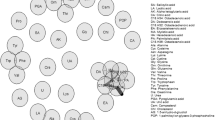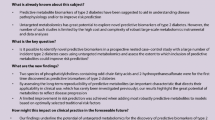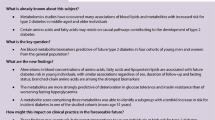Abstract
Metabolomic studies have identified several metabolites associated with type 2 diabetes (T2D) in populations of European ancestry. East Asians, a population of particular susceptibility to T2D, were generally not included in previous studies. We examined the associations of plasma metabolites with risk and prevalence of T2D in 976 Chinese men and women (40–74 years of age) who were participants of two prospective cohort studies and had no cardiovascular disease or cancer at baseline. Sixty-eight prevalent and 73 incident T2D cases were included. Non-targeted metabolomics was conducted that detected 689 metabolites with known identities and 690 unknown metabolites. Multivariable logistic and Cox regressions were used to evaluate the associations of standardized metabolites with diabetes risk and prevalence. We identified 36 known metabolites and 10 unknown metabolites associated with prevalent and/or incident T2D at false discovery rate <0.05. The known metabolites are involved in metabolic pathways of glycolysis/gluconeogenesis, branched-chain amino acids, other amino acids, fatty acids, glycerophospholipids, androgen, and bradykinin. Six metabolites showed independent associations with incident T2D: 1,5-anhydroglucitol, mannose, valine, 3-methoxytyrosine, docosapentaenoate (22:5n3), and bradykinin-hydroxy-pro(3). Each standard deviation increase in these metabolites was associated with a 40–150 % change in risk of developing diabetes (30–80 % after further adjustment for glucose). Risk prediction was significantly improved by adding these metabolites in addition to known T2D risk factors, including central obesity and glucose. These findings suggest that hexoses, branched-chain amino acids, and yet to be validated novel plasma metabolites may improve risk prediction and mechanistic understanding of T2D in Chinese populations.


Similar content being viewed by others
References
Alvim, R. O., Santos, P. C. J. L., Nascimento, R. M., Coelho, G. L. L. M., Mill, J. G., et al. (2012). BDKRB2 +9/− 9 polymorphism is associated with higher risk for diabetes mellitus in the Brazilian general population. Journal of Diabetes Research, 2012, e480251. doi:10.1155/2012/480251.
Aviles-Olmos, I., Dickson, J., Kefalopoulou, Z., Djamshidian, A., Ell, P., Soderlund, T., et al. (2013). Exenatide and the treatment of patients with Parkinson’s disease. Journal of Clinical Investigation, 123(6), 2730–2736. doi:10.1172/JCI68295.
Bain, J. R., Stevens, R. D., Wenner, B. R., Ilkayeva, O., Muoio, D. M., & Newgard, C. B. (2009). Metabolomics applied to diabetes research moving from information to knowledge. Diabetes, 58(11), 2429–2443. doi:10.2337/db09-0580.
Chan, J. C. N., Zhang, Y., & Ning, G. (2014). Diabetes in China: A societal solution for a personal challenge. The Lancet Diabetes & Endocrinology, 2(12), 969–979. doi:10.1016/S2213-8587(14)70144-5.
Connolly, B. S., & Lang, A. E. (2014). Pharmacological treatment of parkinson disease: A review. JAMA, 311(16), 1670–1683. doi:10.1001/jama.2014.3654.
DeFronzo, R. A. (2011). Bromocriptine: A sympatholytic, D2-dopamine agonist for the treatment of type 2 diabetes. Diabetes Care, 34(4), 789–794. doi:10.2337/dc11-0064.
Dungan, K. M., Buse, J. B., Largay, J., Kelly, M. M., Button, E. A., Kato, S., & Wittlin, S. (2006). 1,5-Anhydroglucitol and postprandial hyperglycemia as measured by continuous glucose monitoring system in moderately controlled patients with diabetes. Diabetes Care, 29(6), 1214–1219. doi:10.2337/dc06-1910.
Evans, A. M., DeHaven, C. D., Barrett, T., Mitchell, M., & Milgram, E. (2009). Integrated, nontargeted ultrahigh performance liquid chromatography/electrospray ionization tandem mass spectrometry platform for the identification and relative quantification of the small-molecule complement of biological systems. Analytical Chemistry, 81(16), 6656–6667. doi:10.1021/ac901536h.
Ferrannini, E., Natali, A., Camastra, S., Nannipieri, M., Mari, A., Adam, K.-P., et al. (2013). Early metabolic markers of the development of dysglycemia and type 2 diabetes and their physiological significance. Diabetes, 62(5), 1730–1737. doi:10.2337/db12-0707.
Floegel, A., Stefan, N., Yu, Z., Mühlenbruch, K., Drogan, D., Joost, H.-G., et al. (2013). Identification of serum metabolites associated with risk of type 2 diabetes using a targeted metabolomic approach. Diabetes, 62(2), 639–648. doi:10.2337/db12-0495.
Gall, W. E., Beebe, K., Lawton, K. A., Adam, K.-P., Mitchell, M. W., Nakhle, P. J., et al. (2010). α-Hydroxybutyrate is an early biomarker of insulin resistance and glucose intolerance in a nondiabetic population. PLoS ONE, 5(5), e10883. doi:10.1371/journal.pone.0010883.
Goldstein, D. S., Eisenhofer, G., & Kopin, I. J. (2003). Sources and significance of plasma levels of catechols and their metabolites in humans. Journal of Pharmacology and Experimental Therapeutics, 305(3), 800–811. doi:10.1124/jpet.103.049270.
Hodge, A. M., English, D. R., O’Dea, K., Sinclair, A. J., Makrides, M., Gibson, R. A., & Giles, G. G. (2007). Plasma phospholipid and dietary fatty acids as predictors of type 2 diabetes: Interpreting the role of linoleic acid. The American Journal of Clinical Nutrition, 86(1), 189–197.
Hu, F. B. (2011). Globalization of diabetes the role of diet, lifestyle, and genes. Diabetes Care, 34(6), 1249–1257. doi:10.2337/dc11-0442.
Huang, T., Wahlqvist, M. L., Xu, T., Xu, A., Zhang, A., & Li, D. (2010). Increased plasma n-3 polyunsaturated fatty acid is associated with improved insulin sensitivity in type 2 diabetes in China. Molecular Nutrition & Food Research, 54(S1), S112–S119. doi:10.1002/mnfr.200900189.
Kodama, K., Tojjar, D., Yamada, S., Toda, K., Patel, C. J., & Butte, A. J. (2013). Ethnic differences in the relationship between insulin sensitivity and insulin response a systematic review and meta-analysis. Diabetes Care, 36(6), 1789–1796. doi:10.2337/dc12-1235.
Kolodka, T., Charles, M. L., Raghavan, A., Radichev, I. A., Amatya, C., Ellefson, J., et al. (2014). Preclinical characterization of recombinant human tissue kallikrein-1 as a novel treatment for type 2 diabetes mellitus. PLoS ONE, 9(8), e103981. doi:10.1371/journal.pone.0103981.
Kröger, J., Zietemann, V., Enzenbach, C., Weikert, C., Jansen, E. H., Döring, F., et al. (2011). Erythrocyte membrane phospholipid fatty acids, desaturase activity, and dietary fatty acids in relation to risk of type 2 diabetes in the European Prospective Investigation into Cancer and Nutrition (EPIC)–Potsdam Study. The American Journal of Clinical Nutrition, 93(1), 127–142. doi:10.3945/ajcn.110.005447.
Kusunoki, M., Tsutsumi, K., Nakayama, M., Kurokawa, T., Nakamura, T., Ogawa, H., et al. (2007). Relationship between serum concentrations of saturated fatty acids and unsaturated fatty acids and the homeostasis model insulin resistance index in Japanese patients with type 2 diabetes mellitus. The Journal of Medical Investigation, 54(3,4), 243–247. doi:10.2152/jmi.54.243.
Li, G., Zhang, P., Wang, J., Gregg, E. W., Yang, W., Gong, Q., et al. (2008). The long-term effect of lifestyle interventions to prevent diabetes in the China Da Qing Diabetes Prevention Study: A 20-year follow-up study. Lancet, 371(9626), 1783–1789. doi:10.1016/S0140-6736(08)60766-7.
Lu, J., Xie, G., Jia, W., & Jia, W. (2013). Metabolomics in human type 2 diabetes research. Frontiers of Medicine, 7(1), 4–13. doi:10.1007/s11684-013-0248-4.
Lynch, C. J., & Adams, S. H. (2014). Branched-chain amino acids in metabolic signalling and insulin resistance. Nature Reviews Endocrinology, 10(12), 723–736. doi:10.1038/nrendo.2014.171.
Ma, R. C. W., & Chan, J. C. N. (2013). Type 2 diabetes in East Asians: Similarities and differences with populations in Europe and the United States. Annals of the New York Academy of Sciences, 1281(1), 64–91. doi:10.1111/nyas.12098.
Ma, R. C. W., Lin, X., & Jia, W. (2014). Causes of type 2 diabetes in China. The Lancet Diabetes & Endocrinology, 2(12), 980–991. doi:10.1016/S2213-8587(14)70145-7.
Marcondes, S., & Antunes, E. (2005). The plasma and tissue kininogen-kallikrein-kinin system: Role in the cardiovascular system. Current Medicinal Chemistry—Cardiovascular & Hematological Agents, 3(1), 33–44. doi:10.2174/1568016052773351.
Mayers, J. R., Wu, C., Clish, C. B., Kraft, P., Torrence, M. E., Fiske, B. P., et al. (2014). Elevation of circulating branched-chain amino acids is an early event in human pancreatic adenocarcinoma development. Nature Medicine, 20(10), 1193–1198. doi:10.1038/nm.3686.
Menni, C., Fauman, E., Erte, I., Perry, J. R. B., Kastenmüller, G., Shin, S.-Y., et al. (2013). Biomarkers for type 2 diabetes and impaired fasting glucose using a nontargeted metabolomics approach. Diabetes, 62(12), 4270–4276. doi:10.2337/db13-0570.
Montanari, D., Yin, H., Dobrzynski, E., Agata, J., Yoshida, H., Chao, J., & Chao, L. (2005). Kallikrein gene delivery improves serum glucose and lipid profiles and cardiac function in streptozotocin-induced diabetic rats. Diabetes, 54(5), 1573–1580. doi:10.2337/diabetes.54.5.1573.
Mook-Kanamori, D. O., Selim, M. M. E.-D., Takiddin, A. H., Al-Homsi, H., Al-Mahmoud, K. A. S., Al-Obaidli, A., et al. (2014). 1,5-Anhydroglucitol in saliva is a noninvasive marker of short-term glycemic control. The Journal of Clinical Endocrinology & Metabolism, 99(3), E479–E483. doi:10.1210/jc.2013-3596.
Moore, S. C., Matthews, C. E., Sampson, J. N., Stolzenberg-Solomon, R. Z., Zheng, W., Cai, Q., et al. (2014). Human metabolic correlates of body mass index. Metabolomics, 10(2), 259–269. doi:10.1007/s11306-013-0574-1.
Nagata, C., Nakamura, K., Wada, K., Tsuji, M., Tamai, Y., & Kawachi, T. (2013). Branched-chain amino acid intake and the risk of diabetes in a japanese community the takayama study. American Journal of Epidemiology, 178(8), 1226–1232. doi:10.1093/aje/kwt112.
Newgard, C. B., An, J., Bain, J. R., Muehlbauer, M. J., Stevens, R. D., Lien, L. F., et al. (2009). A branched-chain amino acid-related metabolic signature that differentiates obese and lean humans and contributes to insulin resistance. Cell Metabolism, 9(4), 311–326. doi:10.1016/j.cmet.2009.02.002.
Noble, D., Mathur, R., Dent, T., Meads, C., & Greenhalgh, T. (2011). Risk models and scores for type 2 diabetes: Systematic review. BMJ, 343, d7163. doi:10.1136/bmj.d7163.
Pan, A., Lucas, M., Sun, Q., et al. (2010). BIdirectional association between depression and type 2 diabetes mellitus in women. Archives of Internal Medicine, 170(21), 1884–1891. doi:10.1001/archinternmed.2010.356.
Pan, A., Schernhammer, E. S., Sun, Q., & Hu, F. B. (2011). Rotating night shift work and risk of type 2 diabetes: Two prospective cohort studies in women. PLoS Med, 8(12), e1001141. doi:10.1371/journal.pmed.1001141.
Patel, P. S., Sharp, S. J., Jansen, E., Luben, R. N., Khaw, K.-T., Wareham, N. J., & Forouhi, N. G. (2010). Fatty acids measured in plasma and erythrocyte-membrane phospholipids and derived by food-frequency questionnaire and the risk of new-onset type 2 diabetes: A pilot study in the European Prospective Investigation into Cancer and Nutrition (EPIC)–Norfolk cohort. The American Journal of Clinical Nutrition, 92(5), 1214–1222. doi:10.3945/ajcn.2010.29182.
Qin, L.-Q., Xun, P., Bujnowski, D., Daviglus, M. L., Horn, L. V., Stamler, J., & He, K. (2011). Higher branched-chain amino acid intake is associated with a lower prevalence of being overweight or obese in middle-aged east asian and western adults. The Journal of Nutrition, 141(2), 249–254. doi:10.3945/jn.110.128520.
Sampson, J. N., Boca, S. M., Shu, X. O., Stolzenberg-Solomon, R. Z., Matthews, C. E., Hsing, A. W., et al. (2013). Metabolomics in epidemiology: Sources of variability in metabolite measurements and implications. Cancer Epidemiology, Biomarkers & Prevention: A Publication of the American Association for Cancer Research, Cosponsored by the American Society of Preventive Oncology, 22(4), 631–640. doi:10.1158/1055-9965.EPI-12-1109.
Schoepf, D., Potluri, R., Uppal, H., Natalwala, A., Narendran, P., & Heun, R. (2012). Type-2 diabetes mellitus in schizophrenia: Increased prevalence and major risk factor of excess mortality in a naturalistic 7-year follow-up. European Psychiatry, 27(1), 33–42. doi:10.1016/j.eurpsy.2011.02.009.
Shimomura, Y., Murakami, T., Nakai, N., Nagasaki, M., & Harris, R. A. (2004). Exercise promotes BCAA catabolism: Effects of BCAA supplementation on skeletal muscle during exercise. The Journal of Nutrition, 134(6), 1583S–1587S.
Shu, X.-O., Li, H., Yang, G., Gao, J., Cai, H., Takata, Y., et al. (2015). Cohort profile: The shanghai men’s health study. International Journal of Epidemiology, dyv013. doi:10.1093/ije/dyv013.
Suhre, K. (2014). Metabolic profiling in diabetes. Journal of Endocrinology, 221(3), R75–R85. doi:10.1530/JOE-14-0024.
Suhre, K., Meisinger, C., Döring, A., Altmaier, E., Belcredi, P., Gieger, C., et al. (2010). Metabolic footprint of diabetes: A multiplatform metabolomics study in an epidemiological setting. PLoS ONE, 5(11), e13953. doi:10.1371/journal.pone.0013953.
Tai, E. S., Tan, M. L. S., Stevens, R. D., Low, Y. L., Muehlbauer, M. J., Goh, D. L. M., et al. (2010). Insulin resistance is associated with a metabolic profile of altered protein metabolism in Chinese and Asian-Indian men. Diabetologia, 53(4), 757–767. doi:10.1007/s00125-009-1637-8.
Taneera, J., Lang, S., Sharma, A., Fadista, J., Zhou, Y., Ahlqvist, E., et al. (2012). A Systems genetics approach identifies genes and pathways for type 2 diabetes in human islets. Cell Metabolism, 16(1), 122–134. doi:10.1016/j.cmet.2012.06.006.
The World Bank (2011) Toward a healthy and harmonious life in china: Stemming the rising tide of non-communicable diseases (No. World Bank Report Number 62318-CN).
Tiffin, N., Adie, E., Turner, F., Brunner, H. G., van Driel, M. A., Oti, M., et al. (2006). Computational disease gene identification: A concert of methods prioritizes type 2 diabetes and obesity candidate genes. Nucleic Acids Research, 34(10), 3067–3081. doi:10.1093/nar/gkl381.
Tillin, T., Hughes, A. D., Wang, Q., Würtz, P., Ala-Korpela, M., Sattar, N., et al. (2015). Diabetes risk and amino acid profiles: Cross-sectional and prospective analyses of ethnicity, amino acids and diabetes in a South Asian and European cohort from the SABRE (Southall And Brent REvisited) Study. Diabetologia, 58(5), 968–979. doi:10.1007/s00125-015-3517-8.
Tomita, H., Sanford, R. B., Smithies, O., & Kakoki, M. (2012). The kallikrein–kinin system in diabetic nephropathy. Kidney International, 81(8), 733–744. doi:10.1038/ki.2011.499.
Wang, T. J., Larson, M. G., Vasan, R. S., Cheng, S., Rhee, E. P., McCabe, E., et al. (2011). Metabolite profiles and the risk of developing diabetes. Nature Medicine, 17(4), 448–453. doi:10.1038/nm.2307.
Wang-Sattler, R., Yu, Z., Herder, C., Messias, A. C., Floegel, A., He, Y., et al. (2012). Novel biomarkers for pre-diabetes identified by metabolomics. Molecular Systems Biology, 8(1), 615. doi:10.1038/msb.2012.43.
Xu, F., Tavintharan, S., Sum, C. F., Woon, K., Lim, S. C., & Ong, C. N. (2013a). Metabolic signature shift in type 2 diabetes mellitus revealed by mass spectrometry-based metabolomics. The Journal of Clinical Endocrinology & Metabolism, 98(6), E1060–E1065. doi:10.1210/jc.2012-4132.
Xu, Y., Wang, L., He, J., et al. (2013b). Prevalence and control of diabetes in Chinese adults. JAMA, 310(9), 948–959. doi:10.1001/jama.2013.168118.
Zhang, G., Sun, Q., Hu, F. B., Ye, X., Yu, Z., Zong, G., et al. (2012). Erythrocyte n-3 fatty acids and metabolic syndrome in middle-aged and older Chinese. The Journal of Clinical Endocrinology and Metabolism, 97(6), E973–E977. doi:10.1210/jc.2011-2997.
Zheng, W., Chow, W.-H., Yang, G., Jin, F., Rothman, N., Blair, A., et al. (2005). The Shanghai Women’s Health Study: Rationale, study design, and baseline characteristics. American Journal of Epidemiology, 162(11), 1123–1131. doi:10.1093/aje/kwi322.
Acknowledgments
We thank Dr. Joshua Sampson for his comments on the paper. We thank Ms. Nancy Kennedy for her assistance on preparing the manuscript. We thank the research team and participants of the Shanghai Women’s Health Study and the Shanghai Men’s Health Study for their foundation work for this study.
Author information
Authors and Affiliations
Corresponding author
Ethics declarations
Conflict of interest
The authors, including Danxia Yu, Steven C. Moore, Charles E. Matthews, Yong-Bing Xiang, Xianglan Zhang, Yu-Tang Gao, Wei Zheng, and Xiao-Ou Shu, have no conflict of interest to declare. The study uses existing data and specimens that have already been collected by the parent studies, i.e., the Shanghai Women’s Health Study and the Shanghai Men’s Health Study. All study participants provided informed consent to the parent studies.
Funding
This work was supported, in part, by the US National Institutes of Health [R37 CA070867 and UM1 CA182910 to Dr. W. Zheng, UM1 CA173640, R01 HL079123 and NO2-CP11010-66 to Dr. X.O. Shu]. This work was also supported, in part, by the Breast Cancer Research Stamp Fund, awarded through competitive peer review and the Intramural Research Program of the National Cancer Institute, National Institutes of Health.
Rights and permissions
About this article
Cite this article
Yu, D., Moore, S.C., Matthews, C.E. et al. Plasma metabolomic profiles in association with type 2 diabetes risk and prevalence in Chinese adults. Metabolomics 12, 3 (2016). https://doi.org/10.1007/s11306-015-0890-8
Received:
Accepted:
Published:
DOI: https://doi.org/10.1007/s11306-015-0890-8




